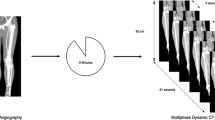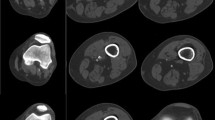Abstract
The purpose was to evaluate the accuracy of multidetector CT angiography (MD-CTA) in the morphologic assessment of peripheral arterial occlusive disease (PAOD) compared to digital subtraction angiography (DSA). Fifty consecutive patients referred for DSA of the peripheral arteries due to PAOD were prospectively included in this study and underwent 16-row MD-CTA prior to DSA. Maximum intensity projections and multipath curved planar reformations were created with a semi-automated toolbox. Twenty-one vascular segments were defined in each leg and compared to DSA findings with regard to gradation, length, and number of lesions. Mean sensitivity and specificity in the detection of significant stenoses (over 70%) were 100% and 99.5% in the iliac arteries, 97.4% and 99.0% in the femoro-popliteal arteries, and 98.3% and 99.8% in the infrapopliteal arteries, respectively. High kappa values for exact stenoses gradation (0.74–1), lesion length (0.74–1), and number of lesions (0.71–1) were reached by MD-CTA, indicating high agreement with DSA. Non-invasive MD-CTA is an accurate tool for the assessment of all treatment-relevant morphologic information of PAOD (gradation, length, and number of stenoses) compared to DSA.



Similar content being viewed by others
References
Waugh JR, Sacharias N (1992) Arteriographic complications in the DSA era. Radiology 182:243–246
Lawrence JA, Kim D, Kent KC, Stehling MK, Rosen MP, Raptopoulos V (1995) Lower extremity spiral CT angiography versus catheter angiography. Radiology 194:903–908
Rieker O, Duber C, Schmiedt W, von Zitzewitz H, Schweden F, Thelen M (1996) Prospective comparison of CT angiography of the legs with intraarterial digital subtraction angiography. Ajr 166:269–276
Rubin GD, Schmidt AJ, Logan LJ, Olcott C, Zarins CK, Napel S et al (1999) Multidetector-row CT angiography of lower extremity occlusive disease: a new application for CT scanning. Radiology 210:588
Rubin GD, Schmidt AJ, Logan LJ, Sofilos MC (2001) Multi-detector row CT angiography of lower extremity arterial inflow and runoff: initial experience. Radiology 221:146–158
Catalano C, Fraioli F, Laghi A, Napoli A, Bezzi M, Pediconi F et al (2004) Infrarenal aortic and lower-extremity arterial disease: diagnostic performance of multi-detector row CT angiography. Radiology 231:555–563
Martin ML, Tay KH, Flak B, Fry PD, Doyle DL, Taylor DC et al (2003) Multidetector CT angiography of the aortoiliac system and lower extremities: a prospective comparison with digital subtraction angiography. Ajr 180:1085–1091
Portugaller HR, Schoellnast H, Hausegger KA, Tiesenhausen K, Amann W, Berghold A (2004) Multislice spiral CT angiography in peripheral arterial occlusive disease: a valuable tool in detecting significant arterial lumen narrowing? Eur Radiol 14:1681–1687
Willmann JK, Baumert B, Schertler T, Wildermuth S, Pfammatter T, Verdun FR et al (2005) Aortoiliac and lower extremity arteries assessed with 16-detector row CT angiography: Prospective comparison with digital subtraction angiography. Radiology 236:1083–1093
Norgren L, Hiatt WR, Dormandy JA, Nehler MR, Harris KA, Fowkes FG (2007) Inter-Society Consensus for the Management of Peripheral Arterial Disease (TASC II). J Vasc Surg 45:S5–S67
Fleischmann D, Kanitsar A, Lomoschitz E, Koechl A (2002) Multi-path curved planar reformation of the peripheral arterial tree. Radiology 225:363
Fleischmann D, Rubin GD, Bankier AA, Hittmair K (2000) Improved uniformity of aortic enhancement with customized contrast medium injection protocols at CT angiography. Radiology 214:363–371
Kanitsar A (2001) Advanced visualzation techniques for vessel investigation [Master Thesis]. Vienna, University of Technology
Kanitsar A, Fleischmann D, Wegenkittl R, Felkel P, Groeller E (2002) CPR-curved planar reformation. IEEE Visualization; 2002. IEEE Computer Society, Boston, pp 37–44
Kanitsar A, Wegenkittl R, Felkel P, Fleischmann D, Sandner D, Groeller E (2001) Computed tomography angiography: a case study of peripheral vessel investigation. IEEE visualization 2001. San Diego, pp 477–80
Kanitsar A, Wegenkittl R, Felkel P, Sandner D, Groeller E, Fleischmann D (2001) Automated vessel detection at lower extremity multislice CTA. Eur Radiol 11(S1):236
Acknowledgements
This work was supported by Fonds zur Förderung der wissenschaftlichen Forschung (FWF, Austria) under the contract no. L291–N04.
Author information
Authors and Affiliations
Corresponding author
Rights and permissions
About this article
Cite this article
Schernthaner, R., Stadler, A., Lomoschitz, F. et al. Multidetector CT angiography in the assessment of peripheral arterial occlusive disease: accuracy in detecting the severity, number, and length of stenoses. Eur Radiol 18, 665–671 (2008). https://doi.org/10.1007/s00330-007-0822-8
Received:
Revised:
Accepted:
Published:
Issue Date:
DOI: https://doi.org/10.1007/s00330-007-0822-8




